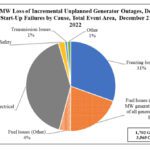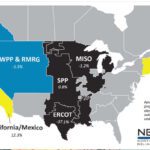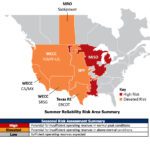The rolling blackouts that affected nearly 4.4 million electric customers in the Southwest during the bitter cold snap from Feb. 2 to Feb. 4 this year could have been prevented by measures such as winterizing power plants and increasing natural gas storage capacity, the Federal Energy Regulatory Commission (FERC) and North American Electric Reliability Corporation (NERC) said after concluding a six-month inquiry into the outages.
“Concluding a six-month inquiry, the task force found a majority of the electric outages and gas shortages were due to weather-related causes,” the agencies said in a report released on Tuesday. “Although generators and gas producers reported having winterization procedures and practices in place, responses were generally reactive in their approach to winterization and preparedness.”
The FERC and NERC taskforce assigned with conducting the inquiry concluded that the actions of the grid-operating entities in calling for and carrying out the rolling blackouts were "largely effective and timely." However, the report notes, "massive amount of generator failures that were experienced raises the question whether it would have been helpful to increase reserve levels going into the event. This action would have brought more units online earlier, might have prevented some of the freezing problems the generators experienced, and could have exposed operational problems in time to implement corrections before the units were needed to meet customer demand."
One solution is to bring more black start units online—especially when a severe weather event is anticipated, it says.
Requiring That Generators Winterize Power Plants
Significantly, the task force found that no state, regional or NERC standards mandated that generators winterize their power plants. The report recommends that states in the Southwest examine whether to require winterization plans, and NERC said it plans to work with industry to develop changes to NERC Reliability Standards to properly address winterization needs.
The task force attributed most of the natural gas shortages and outages to prolonged freezing weather that resulted in dramatically reduced supply and unprecedented high demand. Interstate and intrastate pipelines showed flexibility in meeting demand and compensating for supply shortfalls, it said, but additional storage capacity in Arizona and New Mexico might have prevented many of the outages. Most electric outages were caused by weather-related mechanical problems such as frozen sensing lines, equipment, water lines and valves.
The report also addresses the interdependency of the electric and natural gas industries. “Utilities are becoming increasingly reliant on gas-fired generation, in large part because shale production has dramatically reduced the cost of gas,” it says. “Likewise, compressors used in the gas industry are more likely than in the past to be powered with electricity, rather than gas. As a result, deficiencies in the supply of either electricity or natural gas affect not only consumers of that commodity, but of the other commodity as well.”
In other recommendations, the report says:
- Generation owners and operators should ensure adequate construction, maintenance and inspection of freeze protection elements such as insulation, heat tracing and wind breaks.
- Reliability coordinators and balancing authorities should require generators to provide accurate data about the temperature limits of units so they know whether they can rely on those units during extreme weather.
- Balancing authorities should review the distribution of reserves to ensure that they are useable and deliverable during contingencies.
- State lawmakers and regulators in Texas and New Mexico, working with industry, should determine if weather-related production shortages can be mitigated through the adoption of minimum winterization standards for natural gas production and processing facilities.
The Arctic Blast That Shut the Lights Off
In the first week of February, the Southwest U.S. experienced unusually cold and windy weather with lows during the period staying in the teens for five consecutive mornings, and there were many sustained hours of below-freezing temperatures throughout Texas and in New Mexico. The agencies noted, however, that the storm wasn’t without precedent: At least six other comparable events preceded it in the last two decades, the worst of which was in 1989—when ERCOT resorted to systemwide rolling blackouts.
According to the report, between Feb. 1 and Feb. 4, for the Southwest as a whole, 67% of the generator failures (by MWh) were due directly to weather-related causes, including frozen sensing lines, frozen equipment, frozen water lines, frozen valves, blade icing, low temperature cutoff limits, and the like. At least another 12% were indirectly attributable to the weather—including natural gas curtailments to gas-fired generators and difficulties in fuel switching.
A total of 210 individual generating units within the footprint of the Electric Reliability Council of Texas (ERCOT), which covers most of Texas, experienced either an outage, a derate, or a failure to start. The loss of generation was severe enough on Feb. 2 to trigger a controlled load shed of 4 GW. Spot prices in ERCOT hit the $3,000 per MWh cap on Feb. 2, the worst day of the event. The following day, local transmission constraints coupled with the loss of local generation triggered load shedding for another 180,000 customers in the Rio Grande Valley in south Texas.
ERCOT wasn’t alone, the report says. El Paso Electric Co. (EPE), which is outside the ERCOT region, lost approximately 646 MW of local generation over the four days beginning on Feb. 1. It implemented rotating load sheds on each of the days from February 2 through February 4, totaling over 1,000 MW and affecting 253,000 customers. The Salt River Project Agricultural Improvement and Power District (SRP) in Arizona lost 1,050 MW of generation on Feb. 1 through Feb. 2 and shed load of 300 MW, affecting approximately 65,000 customers.
Meanwhile, the New Mexico communities of Alamogordo, Ruidoso, and Clayton lost approximately 26 MW of load, affecting a little over 21,000 customers, when Public Service Company of New Mexico experienced localized transmission failures, although these were largely unrelated to the extreme weather, the agencies found. A number of entities within the Southwest Power Pool (SPP) also experienced outages during the event, but load shedding was not required—only because the utilities were able to purchase emergency power from other SPP members.
Sources: POWERnews, FERC, NERC










